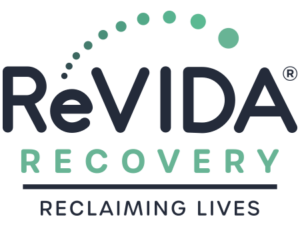
Tennessee has seen its fair share of opioid use over the years. At ReVIDA Recovery®, we’re always looking for opportunities to educate others on the consequences of using opioids long-term – especially because of how many problems they’re causing in our community. While the laws for prescribing opioids have gotten stricter over the years, this medication is still being used illicitly. Two of the most commonly used (and prescribed) opioids are hydrocodone (Vicodin®) and oxycodone (OxyCONTIN®). Are they safe? And why are so many people forming a dependence on them?
Table of Contents
What is Oxycodone?
Oxycodone is a semi-synthetic opioid, which means it’s made in a lab and distributed for medical purposes. It’s only prescribed when a patient is in extreme pain and regular, over-the-counter pain medication isn’t working. For those who are recovering from surgery, living with cancer, or dealing with severe pain, oxycodone can be incredibly helpful. It’s usually only prescribed for 3 days at a time. If someone needs to take it longer than that, an extensive process is required. Why? Because this opioid is considered high-risk for dependency issues. This means that some patients can develop opioid use disorder (OUD) as a result of taking this medication.
Oxycodone comes in a variety of colors, but it’s almost always presented in a round pill form. When people misuse this drug, they might crush it, chew it, or mix it with water and inject it. Common brands of oxycodone include Dazidox®, Eth-Oxydose®, OxyCONTIN®, Roxicodone®, or Roxicodone Intensol®. Oxycodone’s “street names” are Hillbilly Heroin, Roxy, Perc, OC, Oxy, and Kicker.
What is Hydrocodone and How Is It Different From Oxycodone?
Hydrocodone is incredibly similar to oxycodone – so much so that it’s tricky to tell them apart. Just like oxycodone, hydrocodone comes in a pill form and is illicitly used in the same ways. It’s another semi-synthetic opioid that’s used to treat severe and intense pain. Hydrocodone is frequently mixed with acetaminophen in prescriptions for instant pain relief, and you won’t see that as much in oxycodone.
The other noticeable difference between hydrocodone and oxycodone is the side effects. When patients take hydrocodone they’re more likely to have gastrointestinal upset like nausea and constipation. Some say that oxycodone is stronger for pain relief, but that’s not a proven fact.
Common brand names of hydrocodone include Lortab®, Norco®, and Vicodin®. Popular “street names” for this medication include Vike, Fluff, Hydros, and Bananas.
What are the Side Effects of Oxycodone and Hydrocodone?
Just like any medication, opioids come with their fair share of side effects. Here are some common short-term side effects of oxycodone:
- Headaches or migraines
- Dry mouth
- Fatigue
- Mood swings
- Sweating
- Muscle weakness
- Vomiting
- Stomach discomfort
- Constipation
- Loss of appetite
And here are some common short-term side effects of hydrocodone:
- Anxiety or panic attacks
- Fatigue
- Dizziness
- Constipation
- Nausea
- Stomach upset
- Headache or migraine
- Nightmares
- Insomnia
- Muscle weakness
That being said, people who take oxycodone or hydrocodone illicitly will take them for their desired side effects, which include:
- The absence of stress or worry
- Overall feeling of being relaxed
- Euphoria
- Increased feelings of well-being
- Numbness
- Lethargy
People who are taking opioids outside of a doctor’s care will often say things like “it takes away the pain completely” or, “when I take it, all of my problems melt away.” This is because of the way hydrocodone and oxycodone interact with the brain. The feeling of being happy and weightless comes with the territory for many who take these drugs, but it doesn’t last forever. When the drug wears off, so do the feelings of euphoria and relaxation.
Are Oxycodone and Hydrocodone Addictive?
These medications alone are not “addictive.” When they’re used for a prolonged period, the person using them may develop a tolerance. This means that they’ll need more and more of the drug to achieve similar results. The brain gets used to receiving hydrocodone or oxycodone every day, and when someone suddenly stops taking it or decreases their dosage, it can cause withdrawal symptoms. This can be avoided by following your doctor’s prescription and not straying from their advice.
What Happens When Someone Becomes Dependent on Opioids?
Opioid dependency is common, even when someone is following their doctor’s orders. But it’s not a death sentence, and it’s manageable with treatment. That being said, here are some common things that someone with an opioid dependency might experience:
- They may experience withdrawal Symptoms. This is what happens when someone either stops taking the medication or lowers the dosage. When opioids are taken, the brain is flooded with dopamine – a “feel-good” neurotransmitter responsible for feelings of pleasure. The brain gets used to this level of dopamine, and when the dosage drops or it’s stopped altogether, it experiences dopamine deficiency. Withdrawals can begin anywhere from 6-24 hours after the last dose of hydrocodone or oxycodone, and they progress in severity. Sometimes these withdrawal symptoms can be unsafe if someone isn’t seeking professional help, so we always recommend that someone is under a doctor’s care when they’re coming off of opioids.
- They may experience cravings. Cravings can be frustrating. It’s hard to want to stop using opioids but feel like you need them at the same time. These cravings can be managed with things like medication or therapy, but it’s not an easy process. Cravings prevent some people from leaving opioids behind.
- They may experience job loss or loss of friendships. Opioid Use Disorder (OUD) can be a lonely affair. It causes people to isolate themselves from others because they don’t want to be judged or be around people who aren’t using. OUD can also cause fatigue, muscle weakness, headaches, or other things that impact job performance.
- They might struggle with their mental health. Having OUD is hard on the mind. People with OUD experience depression, anxiety, guilt, and sometimes even suicidal thoughts.
- They may experience physical health issues. When used for longer than prescribed, opioids can cause health issues like gastrointestinal problems (constipation or bowel obstructions), tooth decay, sleep apnea, and more.
What is an Opioid Overdose?
Sadly, opioid overdoses are fairly common. Tennessee alone saw almost 4,000 opioid-related overdose deaths in 2021. Thousands of others experience non-fatal overdoses every day. When someone takes too much oxycodone or hydrocodone (which is easy to do when tolerance is formed), the body rebels by shutting down. Mixing opioids with other drugs or alcohol increases the probability of an overdose.
The physical signs of oxycodone or hydrocodone overdose are:
- Tiny pupils
- Nausea or vomiting
- Constipation
- Drowsiness
- Coma
- Seizures
- Low blood pressure
- Weak or thready pulse
- Difficulty breathing
- Shallow breathing
- Slow breathing
- Blue fingernails, lips, or eyelids
If you notice these signs in yourself or in someone you love, call 911 and get help immediately.
NOTE: Under present Tennessee law, a person who seeks medical assistance for a person experiencing or believed to be experiencing a drug overdose will NOT be charged for any drug violations. That means if you’ve been using recreational drugs and you’re worried about getting in trouble, keep in mind that you will not be arrested, charged, or prosecuted for having drugs in your possession or in your system.
ReVIDA Recovery® is passionate about helping others reclaim their lives from oxycodone addiction treatment. If you or someone you know is living with an opioid use disorder, call us today at 423-631-0432 so we can help!
FAQs About The Difference Between Oxycodone And Hydrocodone
What are oxycodone and hydrocodone used for?
Both oxycodone and hydrocodone are prescribed for pain management post-surgery, during cancer, or in the event of a major injury. They’re not meant to be used recreationally.
Is hydrocodone or oxycodone better?
Both hydrocodone and oxycodone come from the same family of semi-synthetic opioids. Their similarities are much greater than their differences, and one does not work better than another. Different medications can impact people differently, so what works for one person may not work as well for another, and vice versa.
Is it possible to get addicted to hydrocodone or oxycodone?
Yes, both of these medications have the potential to create dependency or OUD. This can be avoided when following a doctor’s advice and prescription.










